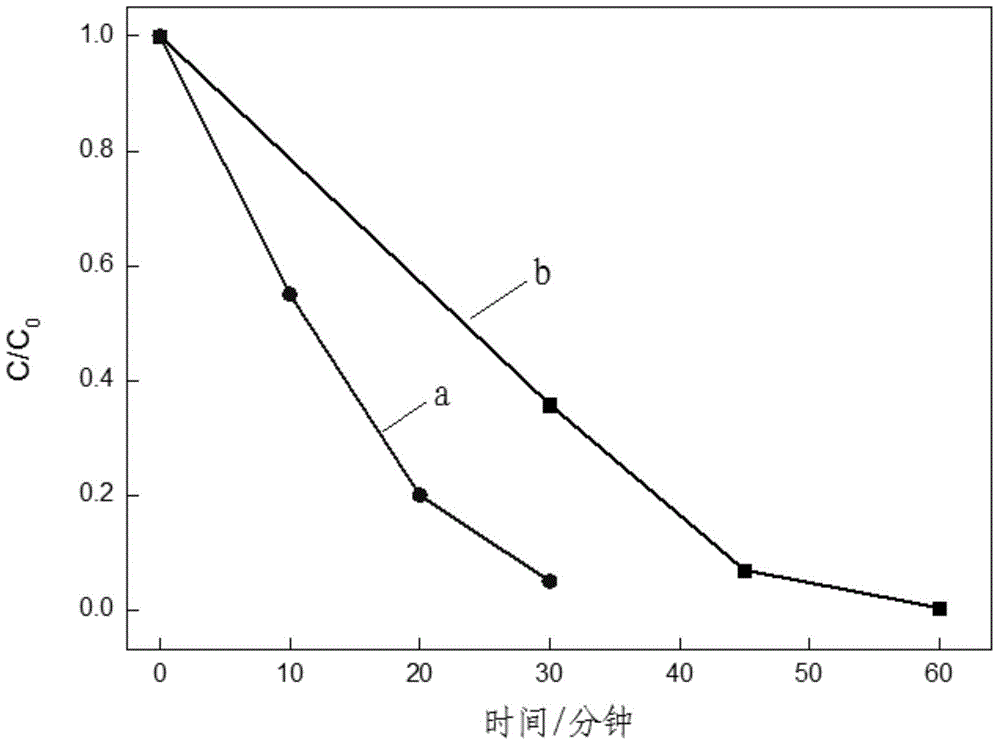Preparation process of sulfur and rare-earth element doped nano titanium dioxide three-element photocatalyst
A nano-titanium dioxide and rare earth element technology, applied in the direction of light water/sewage treatment, etc., can solve the problems of inability to improve catalytic efficiency and low utilization of sunlight.
- Summary
- Abstract
- Description
- Claims
- Application Information
AI Technical Summary
Problems solved by technology
Method used
Image
Examples
Embodiment 1
[0024] 1) Weigh 2.5 grams of lanthanum oxide with an electronic balance and place it in a beaker, then weigh 3.5 grams of concentrated nitric acid with a mass concentration of 65% and slowly pour it into a beaker containing lanthanum oxide, and keep stirring at 50°C until dissolved. into a lanthanum nitrate solution, and then drying the lanthanum nitrate solution in a drying oven at 55°C to obtain a lanthanum nitrate solid;
[0025] 2) Weigh 0.5 g of lanthanum nitrate solid and add it into 25 ml of distilled water to make an aqueous solution of lanthanum nitrate; weigh 7.5 g of titanium tetrachloride and carefully pour it into a constant pressure dropping funnel, then add a drop of 7 seconds / drop under stirring conditions. Accelerate dropwise addition into a conical flask containing 30 ml of absolute ethanol, and control the temperature at 20 °C during the dropping process to make a transparent titanium tetrachloride absolute ethanol solution; weigh 1.5 g of thiourea and add 6 ...
Embodiment 2
[0028] 1) Weigh 4.5 grams of yttrium oxide with an electronic balance and place it in a beaker, then weigh 3.25 grams of concentrated nitric acid with a mass concentration of 65% and slowly pour it into a beaker containing yttrium oxide, and continuously stir to dissolve under 50 ° C. into yttrium nitrate solution, then drying the yttrium nitrate solution at 55°C in a drying oven to obtain yttrium nitrate solid;
[0029] 2) Weigh 0.35 grams of yttrium nitrate solid and add 25 milliliters of distilled water to make an aqueous solution of yttrium nitrate; Weigh 8.5 grams of titanium tetrachloride and carefully pour it into the constant pressure dropping funnel, then under stirring conditions, drop by 7 seconds / drop. Accelerate dropwise addition into a conical flask containing 30 ml of absolute ethanol, and control the temperature at 20°C during the dropwise addition to make a transparent titanium tetrachloride absolute ethanol solution; weigh 1.35 grams of thiourea and add 6 ml o...
Embodiment 3
[0032] 1) Weigh 3.5 grams of europium oxide with an electronic balance and place it in a beaker, then weigh 2.75 grams of concentrated nitric acid with a mass concentration of 65% and slowly pour it into a beaker containing europium oxide, and continuously stir to dissolve at 50 ° C. into a europium nitrate solution, and then drying the europium nitrate solution in a drying oven at 40 °C to obtain a solid europium nitrate;
[0033]2) Weigh 0.4 grams of solid europium nitrate and add 30 milliliters of distilled water to make an aqueous solution of europium nitrate; Weigh 9.5 grams of titanium tetrachloride and carefully pour it into the constant pressure dropping funnel, then under stirring conditions, drop the solution with a drop of 10 seconds / drop. Accelerate dropwise addition into a conical flask containing 30 ml of absolute ethanol, and control the temperature at 25°C during the dropping process to make a transparent titanium tetrachloride absolute ethanol solution; weigh 5...
PUM
 Login to View More
Login to View More Abstract
Description
Claims
Application Information
 Login to View More
Login to View More - R&D
- Intellectual Property
- Life Sciences
- Materials
- Tech Scout
- Unparalleled Data Quality
- Higher Quality Content
- 60% Fewer Hallucinations
Browse by: Latest US Patents, China's latest patents, Technical Efficacy Thesaurus, Application Domain, Technology Topic, Popular Technical Reports.
© 2025 PatSnap. All rights reserved.Legal|Privacy policy|Modern Slavery Act Transparency Statement|Sitemap|About US| Contact US: help@patsnap.com


